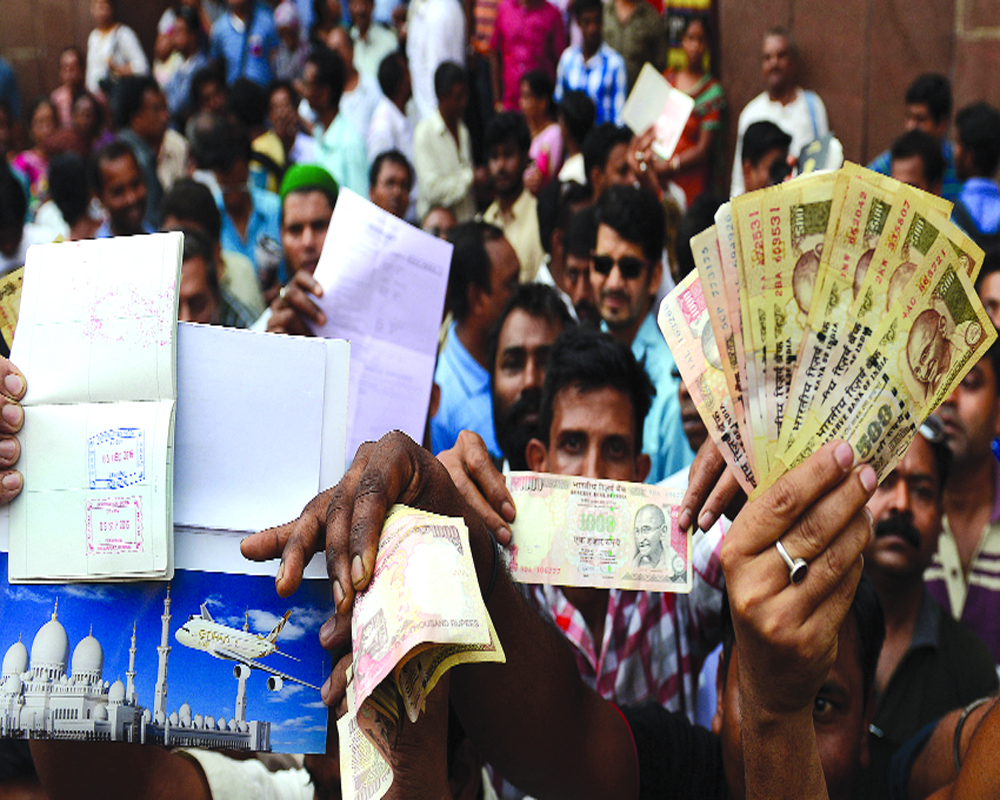Digitisation has improved but is still a very small fraction of cash transactions. Moreover, digitisation in a country like ours is conceivable only in cities
It has been five long years since Prime Minister Narendra Modi announced on November 8, 2016, that the 500 and 1000 notes would not be legal tender from midnight. The brief telecast made a paradigm shift in the life of every Indian. Chaos and confusion followed the announcement. Long serpentine queues were seen outside of banks to change the notes. It was the moment of truth for India. More than 70 people lost their lives to exchange their notes.
We were told it was an attempt to dig out the black money from the system and stop terror funding. The other benefits enumerated included weeding out counterfeits and digitising the economy. Five years have gone by. Let's assess if the cherished goals have been achieved, as the Government is reluctant to do so. Was it at all a masterstroke? Was it a surgical strike on the black money or a strike on the Indian economy?
Demonetisation did away almost 95 per cent of the currency on a four-hour notice. It was chaotic with the Government changing the goal post every second day.
After some time Prime Minister Modi declared that he was no economist and that he had never claimed to be one but his intentions were good. In the same fashion, I can say that I don’t hold a degree in economics but my intentions of revisiting the demonetisation are good. I approach demonetisation as a commoner. I saw and endured the months of upheaval that followed demonetisation.
I as any other countryman can vouch for one fact that black money or the unaccounted money is still there in the system. During the exchange period, some people made a killing by facilitating the exchange. For a fraction of the cost, the black became the new white. Innovative ideas to exchange the old notes were flying all over. You could do it by buying gold, booking railway tickets, buying petrol and so on. But common men saw their marriages broken, jobs lost, cottage business shut and their kin unable to get treatment in hospitals.
Next on the list was terrorism — the lesser said the better. Security experts would be better placed to tell if demonetisation led to any let-up in terrorism. It would be too simplistic to assume that motivated terrorists would stop because they could not exchange their notes. After all their accounts were not frozen.
As for counterfeits, according to the Government's declaration, more than 99 per cent of the currency notes got back into the system.
Digitisation, no doubts, improved but is still a very small fraction of the cash transactions. Moreover, digitisation in a country like ours is conceivable only in cities. India operates on cash. And why should a farmer pay a fraction of money to Paytm for transacting? Digitisation comes with a transaction cost. Japan is still largely a cash economy.
So what was the motive — the real motive — of the Government? The motives were indeed different from the ones propagated.
Maybe one was the upcoming UP elections. In Indian elections cash rules. It stripped the Opposition parties of their cash tranche. Or maybe to shift the fulcrum of the economy from an unorganised to an organised sector. The money started flowing even more vigorously from the common man to entrepreneurs. Whatever it was, it meant severe hardships for the people, small businesses and workers. Eighty-five per cent of the economy is the informal sector which works on 95 per cent cash transactions. It was paralysed with the so-called masterstroke. While the informal sector shrunk the organised sector ate into its chunk. Indeed, they were better equipped to adapt and take advantage of the new digitisation and other policies.
Another big reason could be that the party in power wanted to do something dramatic. To show that it was different from the previous Government and had the wish to purge the economy. It was a quick fix solution, which has hardly ever worked anywhere in the world, but it could be easily sold to common people. The ‘shock and awe’ paradigm was being invoked and put to good political mileage.
An argument often doled out is that if people suffered then how come the NDA Government came back to power in 2019. That has some merit to it. But then people are often unable to connect the dots especially when they are stuck with 'shock and awe'. They feel the hardships they are facing are somehow their follies, or maybe they are unlucky. They fail to connect it to a grand executive order. Moreover, PM Modi came with a lot of goodwill and people presumed he can do no wrong, no evil. Even if it did not work his intentions were good so he deserved a better chance. He was let down by bureaucracy, the corporates and exonerated the concept of demonetisation.
However, after five years, the Government did not do a single press conference or press release commemorating the occasion. No TV ad or newspaper ad was commemorating the occasion. Even the ministers who tweet about anything and everything, gave the fifth birthday of demonetisation a skip. Even the Government wants to forget about it as a nightmare. But can we?
(The writer is a columnist and documentary filmmaker. The views expressed are personal.)
























